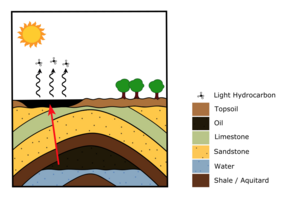La Brea Tar Pits - Simple English Wikipedia, the free encyclopedia


The La Brea tar pits (or Rancho La Brea) are a famous cluster of tar pits in central Los Angeles. Complete skeletons of many thousands of large animals have been found here. They date mostly from 40,000 to 8,000 years ago.
Hancock Park was formed around the tar pits, in the heart of Los Angeles. Asphalt or tar (brea in Spanish) has seeped up from the ground here for tens of thousands of years. The tar is often covered with water. Over many centuries, animals that came to drink the water fell in, sank in the tar, and died. In the tar, their bones turned into fossils.
The George C. Page Museum is dedicated to researching the tar pits and displaying specimens from the animals that died there. The La Brea Tar Pits are now a registered National Natural Landmark.
History of the site
[change | change source]Modern excavations of the bones started in 1913–1915. In the 1940s and 1950s, public excitement was got by the preparation of previously recovered large mammal bones.[1] A later study showed the fossil material was well preserved.[2] They are about 10–20,000 years old, from the last glacial period.[3]
Findings
[change | change source]At the La Brea Tar Pits, scientists have found the skeletons of many prehistoric species, including:
- Mammoths
- American mastodons
- American lions
- American cheetahs
- Dire wolves
- The Western camel Camelops
- Short-faced bears
- Ground sloths
- The saber-toothed cat, Smilodon fatalis (the state fossil of California)
Only one human has ever been found in the tar pits: a partial skeleton of a woman,[4] dated at about 9,000 BC. Because of the way her skull was crushed, scientists think she was murdered.[5][6]
Over a million fossils
[change | change source]Over a million fossils have been recovered from the tar pits. These fossils include individual bones as well as pieces of bone.[7] Scientists estimate that at least 10,000 animals got trapped in the Tar Pits over 30,000 years. These animals belonged to at least 660 different species. This includes at least 135 species of birds, and 59 species of mammals.[7]
Tar pits
[change | change source]
Oil is created when decayed organic matter is underground. It is under pressure. The crude oil seeps upward through fractures, or porous sedimentary rock layers. It may form a pool at the surface.[8]
The lighter parts of the crude oil evaporate into the atmosphere, leaving behind a black, sticky asphalt.[8] Tar pits are often excavated because they contain many fossils.
There are not many of these tar pits in the world, because they only form in these circumstances. The evaporation of the lighter elements in the crude oil is needed to create the sticky tar which traps the animals. Their distress calls are irresistible to the predators which follow them.
References
[change | change source]- ↑ "Animal Bones 50,000 Years Old Found In Tar". Los Angeles Times. Los Angeles. June 17, 1946. Archived from the original on November 6, 2012. Retrieved January 27, 2010.
- ↑ McMenamin M.A.S.; et al. (1982). "Amino acid geochemistry of fossil bones from the Rancho La Brea Asphalt Deposit, California". Quaternary Research. 18 (2): 174–83. Bibcode:1982QuRes..18..174M. doi:10.1016/0033-5894(82)90068-0. S2CID 129195356.
- ↑ Ley, Willy (December 1963). "The Names of the Constellations". For Your Information. Galaxy Science Fiction. pp. 90–99.
- ↑ Cooper, Arnie (May 27, 2010). "Sticky situation at the Tar Pits". L.A. Weekly. Archived from the original on January 1, 2015. Retrieved June 7, 2016.
- ↑ Burbank, Jon (March 1, 1999). "Tar pits still slowly releasing victims". The Japan Times. Retrieved September 1, 2010.
- ↑ Murphy, William S (April 4, 1987). "La Brea tar pits facility will celebrate 10th anniversary". Los Angeles Times. Retrieved September 1, 2010.
- ↑ 7.0 7.1 Harris J.M. and Jefferson G.T. (eds) 1985. Rancho La Brea: treasures of the tar pits. Natural History Museum of Los Angeles County. ISBN 978-0295963051.
- ↑ 8.0 8.1 "La Brea Tar Pits". ucmp.berkeley.edu. Retrieved 2021-04-26.


 French
French Deutsch
Deutsch